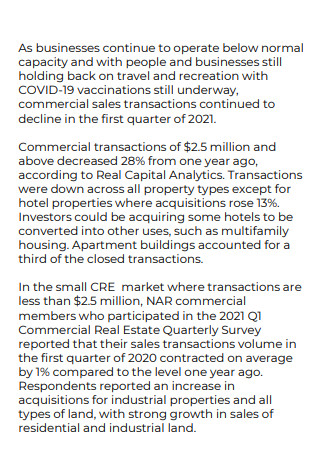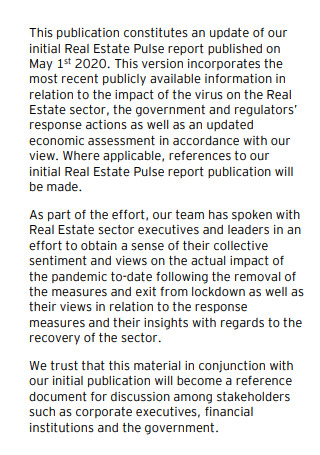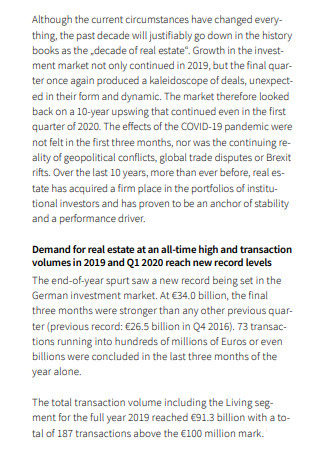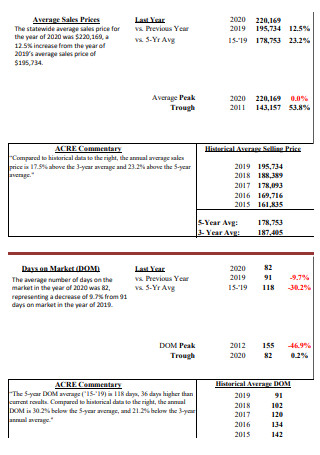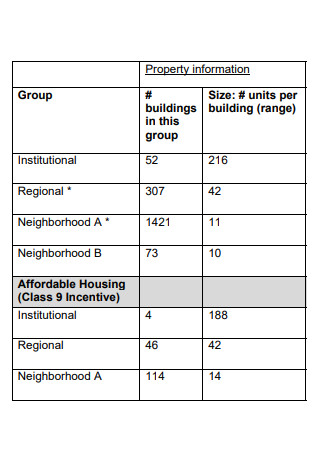5+ SAMPLE Real Estate Business Report
FREE Real Estate Business Report s to Download
5+ SAMPLE Real Estate Business Report
What Is a Real Estate Business Report?
Benefits of a Business Report
How to Write a Real Estate Business Report
Property Investments in Various Real Estate Types
FAQs
What is a real estate business plan?
What is the main purpose of a business proposal?
What are some ways to invest in residential real estate?
What Is a Real Estate Business Report?
Real estate is much more than a plot of land with any natural or intentionally man-made improvements attached or added to it. Trees, water, rich mineral resources, and oil are examples of natural ties to the ground. Buildings, walkways, and fences are examples of artificial enhancements. Real estate is divided into several categories. A real estate report is a compilation of data and analysis that lets a firm obtain essential information quickly. There are many other components of Business Reports, but this article will cover the fundamentals. You can check for the available real estate market report template that has been provided for you so you can have a starting base rather than starting from scratch.
Benefits of a Business Report
When assessing and planning for long-term performance, small firms sometimes find themselves writing company reports. It’s typically a good idea for people creating a financial report to be aware of some of the goals in doing so as well as any potential constraints. Business reports may be a powerful tool when utilized properly, but only if people who use them are aware of the drawbacks. Although, not everything is perfect when writing a business report. All that does matter though, is how it can still be beneficial to your Company and the intended purpose of such document will be dutifully followed through.
How to Write a Real Estate Business Report
A real estate business project report will be useful to keep track of the information and data your real estate company has gathered throughout. And as the business insider real estate reporter you are expected to collect sufficient information and write it in an efficient manner that will be easily reviewed by other people in the company or clients who could benefit from it. This is why learned the content and importance as you will need it to know how to write the report. You should write in a logical and uncomplicated manner. The client or coworker should be able to read your report easily. The following elements should be considered when writing. Be sure to check out the real estate market analysis report sample to see a structured format for yourself.
Step 1: Set Headings and Subheadings
Headings and subheadings might help you determine which point is of utmost importance. They should be detailed and easy to understand. It is not as convenient to number a paragraph as it is to write the numeral. Because of the importance and hierarchy of points, the formatting of the heading should be distinct from that of the subheading. When creating headers and subheadings, you should keep parallelism in mind so that your writing doesn’t seem out of place. Remember that the first word of your heading should be capitalized, but the subsequent words, with the exception of proper nouns, should be written in small characters.
Step 2: Plan out the Contents
A paragraph should be 100-200 words long and follow the pattern. The main concept of your work will be stated in the topic sentence. Explanation sentences that will help you understand what you’re talking about. Supporting phrases that bolster the validity of the concept. Finally, make a decisive conclusion about your creative analysis with a concluding phrase. You should also check to determine if your paragraphs are connected to one another and serve the objective of your report.
Step 3: Write the Sentences
Business writing, particularly reports writing, should be simple and straightforward. It will strengthen the argument. Sentences should be written in plain language for this. Too long and convoluted sentences detract from the reader’s attention and comprehension. You should try shortening or simplifying it. The use of big, technical terms isn’t always appropriate. Begin is preferable to begin, while change is preferable to transformation. The use of active voice rather than passive speech is also a superior choice for helping readers understand.
Step 4: Structuring the Report
The amount of white space in a report is referred to as white spacing. This makes it easier on the reader’s eyes, establishes balance, and provides a nice presentation. This isn’t limited to the headers. Multiple paragraphs, page breaks, and the usage of graphs and charts all aid in the creation of white space. In terms of typeface, a normal size 12 is utilized for text, but larger, bold fonts are employed for headings and subheadings as needed. They can be pre-scripted or completed according to a set of guidelines. In any case, they should be in excellent taste. From the Executive Summary through the table of contents, remember to utilize roman numerals. Also, there is no numbering on your title page.
Step 5: Footnotes and Appendices
Footnotes should not be used excessively. There is no need for a footnote if anything may be put in the text. It should also not be utilized as a source of information. Figures should contain graphical material, such as flow charts, organograms, and excel files, whereas tables should contain statistics or words. These should be supplemental to the content, not merely a box with the text in it. Between the text and the figures, there should be a two-line gap.
Step 6: Remain Professional
Personal pronouns such as we and you can be used in semi-formal reports, but in more official ones, you should avoid them and write a neutral topic. Again, instead of writing particular pronouns, use gender-neutral terms like customers. You should avoid saying things that are insulting to people of any ethnicity or minority. Avoid contractions like it’s and instead use it is for a more official tone. Editing and proofreading are two additional crucial components of writing effectively. When proofreading, look for errors in grammar, spelling, and punctuation, as well as consistency.
Property Investments in Various Real Estate Types
Investing in real estate assets may provide you with a number of ways to increase your equity over time. This, however, is not the only reason why so many people believe these investments are a smart choice. The present market’s demand for Real Estate holdings has greatly outpaced supply, making this an excellent time to begin your investments. However, before you begin, you must first learn about the many forms of real estate investments accessible. Each option has its own set of advantages and disadvantages. Depending on their requirements and ambitions, these diverse property types can benefit various sorts of investors. Interested clients will need to do a thorough review of the property they want to invest in.
FAQs
What is a real estate business plan?
A business plan is a written document that depicts your company’s future. It explains what you are going to do and how you are going to execute it. It expresses your business goals, the strategies and tactics you will employ to achieve them, potential challenges you will face and how to solve them, roles and duties, SWOT analysis, and measurement techniques, among other things. Don’t forget to check out the available business report for real estate that is readily available for you to use as opposed to starting from scratch and consuming precious time that you can instead spend discussing details with clients.
What is the main purpose of a business proposal?
The goal of a business proposal is to persuade the reader or client to view the world of the contents of the proposal through your eyes. When writing a business proposal, your main aim is to persuade the reader to make a change that will allow your suggested concept to become a reality. In the context of real estate, you are able to persuade your clients to trust you and go with the method you are suggesting, as not only will it convince them you know what you are talking about but also because you are the best person for the job. Think thoroughly before writing out a business proposal, which could be useful for your real estate company as well. Check out the available real estate report example to know how to format your report.
What are some ways to invest in residential real estate?
Residential real estate investing may be done in a variety of ways. Some people prefer to repair and change the property, considering it as a short-term investment in which they add value and sell it for a profit. Others opt to engage in residential real estate for the long term by purchasing a property for Cash Flow and renting it out. These are two of the most frequent ways to invest in residential real estate, although there are others, such as vacation homes, wholesaling, crowdfunding, and mortgage notes. While clients can buy a home purely for investment purposes, they can also transform your primary residence through various means. As you are in the process of convincing your clients, preparing a real estate market report investment will come in handy to further persuade them.
You are all set to make your very first real estate offer. The finest real estate report all have one thing in common: they are highly customized to the customer whose company you wish to win. These are the essential components of any winning real estate report. Make sure to include every aspect mentioned in this post, as well as customize your reports for the clients that read them, if you want your reports to gain new business and convert like crazy. If you do these two things correctly, every report you create and send will be successful. What are you waiting for? Get down to writing that real estate monthly market report now!

